
Martin Scorsese and his various key collaborators were all around thirty-years-old when they made . You can look at that and be impressed by the work of such cinematic genius at a relatively young age, but you can also look at that and see how Taxi Driver indeed feels like the work of young men still raging at the world. By the time Scorsese made Bring Out the Dead (1999), his spiritual companion piece to Taxi Driver, he was in his mid-50s. That advanced age combined with an accrued set of life experiences fundamentally changed how he viewed the world. As Scorsese put it, "Frank [Nicholas Cage's character] is not an avenging angel and instead of killing people, our protagonist is trying to save people. It's a different world and we're different now."
However, Taxi Driver is the poster countless film fans put up on their dorm room wall. Travis Bickle is the character people remember, not Frank Pierce. Even twenty years after its release date, Bringing Out the Dead still hardly registers with the general public. Does that mean it's simply not very good? Unjustly overlooked? Or too hard to sell to people? After all, is there anything more to this movie than a tired-looking Nicholas Cage riding around in an ambulance and acting out one mini-episode of ER after another? And what the hell is up with the lighting? Why does it look like someone is periodically pointing a flashlight at the camera?
I watched Bringing Out the Dead in search of some answers. What I found was a remarkably somber, yet fast-moving character study of a man who does not know how to forgive himself.
What's It About
Frank Pierce (Nicholas Cage) - a sleep-deprived paramedic - weathers eccentric partners (John Goodman, Ving Rhames, Tom Sizemore), colorful drug dealers (Cliff Curtis), impatient dispatchers (Queen Latifah, Scorsese, both heard but not seen), and mentally-altered patients across several long night shifts in the parts of New York untouched by Guiliani's clean-up efforts. Every patient Pierce saves is an effort to atone for the one patient he lost, a young hispanic woman named Rose, but the guilt simply won't go away. Nor, the longer this whole sleep-deprivation thing goes on, will the hallucinations. Salvation just might lie with Mary (Patricia Arquette), daughter to an elderly patient Frank manages to save, but falling in love with a woman as her father wastes away in the ER is hardly ideal.
Scorsese's Take
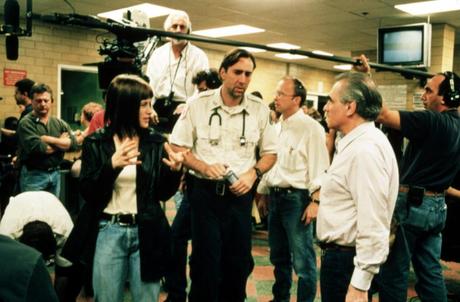
"If anyone had told me I was going to make this film, I would have said they were crazy. It just wasn't planned. But I responded to the beauty of the book and had such an identification with the story, and I loved what [Paul] Schrader did with the characters."
Scorsese's Contrast Between Taxi Driver and Bringing Out the Dead
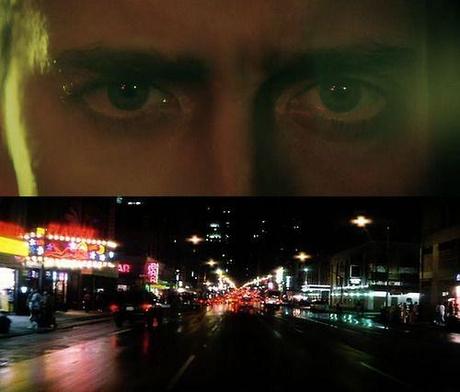
"In Taxi Driver, Travis cast a paranoid eye on the world, and I framed it from his point of view. In Frank's case, it's the images of the outside world, hallucinatory images that assail him, invading his field of vision and lacerating his psyche. After some time, reality is reduced to these visual aggressions: bodies strewn on the sidewalk, faces twisted in pain or withdrawal."
How It Got Made
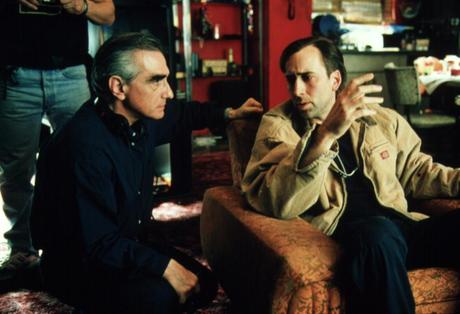
Scott Rudin - now synonymous with the Sony hack but once upon a time one of the hottest producers in Hollywood - sent Scorsese the galleys for Joe Connelly's semi-autobiographical 1998 novel Bringing Out the Dead. At that point, the director was fresh off the commercial failure of Kundun, a biopic about the 14th Dalai Lama, and two years removed from Casino, which had been a bit of a return to form for him. Bringing Out the Dead presented the opportunity to do another New York movie, but his first since Guiliani had cleaned up the streets. It was also a chance to do another Taxi Driver-style profile of one man's relative isolation and mental deterioration but with a protagonist whose instincts trend toward helping others instead of self-destruction.
All of that was nice, but it was a recent personal tragedy which truly drew Scorsese to the material. As he later said, "I don't think I could have done this picture nine years ago. It had to come out of the experience of going into emergency rooms in the middle of the night...My father's death, my mother's death."
While reading Connelly's book, Scorsese immediately pictured Nicholas Cage as the lead, particularly honing in on the imagery of his eyes bearing witness to an endless sea of human suffering. As Frank says at one point in the film, "After a while I grew to understand that my life was less about saving lives than about bearing witness. I was a grief mop. It was enough that I simply showed up."
Cage, not yet the runaway ham the internet adores today, seemed like the perfect voice to say a line like that. It didn't hurt that Scorsese also knew Cage through Francis Ford Coppola and that the actor came highly recommended by Brian De Palma, who had just directed him in Snake Eyes. Paul Schrader, who had worked with Scorsese on Taxi Driver, Raging Bull, and Last Temptation of Christ, was offered the chance to write the script and ended up adding a new ending not featured in the book.
With Schrader's script in hand, Scorsese spent a week in isolation, designing the film shot by shot. Soon enough, they were on set in Hell's Kitchen in Manhattan. Director of photography Robert Richardson, reteaming with Scorsese after Casino, lent his signature contrasting dark/haloed light visuals, which he'd previously been known for due to his work with Oliver Stone on films like Natural Born Killers.
What the Critics Said At at The Time
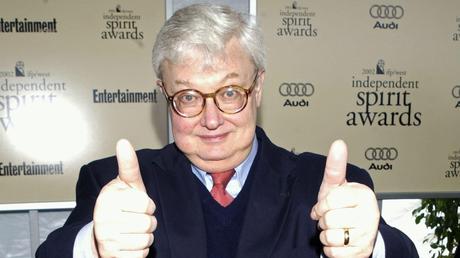
Roger Ebert: "To look at Bringing Out the Dead -to look, indeed, at almost any Scorsese film-is to be reminded that film can touch us urgently and deeply. Scorsese is never on autopilot, never panders, never sells out, always goes for broke; to watch his films is to see a man risking his talent, not simply exercising it. He makes movies as well as they can be made, and I agree with an observation on the Harry Knowles Web site: You can enjoy a Scorsese film with the sound off, or with the sound on and the picture off."
Janet Maslin ofThe New York Times: " Bringing Out the Dead becomes an intense, volatile film full of sorrow and wild, mordant humor. It also becomes an uncertain mix of moods, appropriately manic to suit Frank's stress. There are times when he doesn't know whether to laugh or cry, and audiences won't, either."
What I'll Say Now
Bringing Out the Dead is, essentially, a movie without a plot. That's by design. By virtue of the way one work day tends to blend into the next, particularly if you work at night, Frank Pierce's various journeys into the dregs of Manhattan begin to feel a bit like he's stuck in some kind of purgatory or, less charitably, one very particular circle of Dante's hell. Such religious imagery is likely intended, from the presence of Cage's eyes framed inside a cross on the film's poster to the naming of Patricia Arquette's "symbol of salvation" character as Mary, although that last part is carried over from the novel.
As a result, it's entirely possible to reach the end of Bringing Out the Dead and feel like you've simply watched a rather episodic story of a near-comatose man's wacky encounters with the medically needy underworld of New York. Untold Stories of the ER and various other reality shows offer more obvious medical intrigue. And if you're simply in it to see Nicholas Cage do the over-the-top Nicholas Cage thing you'll have to wait until the third act when Frank finally cracks and even starts to scare his psychotic partner.
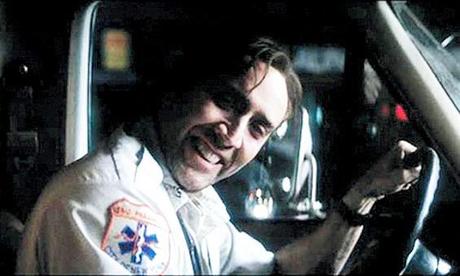
That, for the record, is after Frank's second partner, played by Ving Rhames like a revivalist tent preacher, has crashed their ambulance, but before his third partner, Tom Sizemore, simply takes to beating the shit out of a mentally altered frequent flyer who has popped into the story at every turn.
The film is certainly trying to do something with Frank's rotating partners. The first, Goodman, gets through the shifts by focusing on baser, Earthly pleasures, like where they'll eat next. The second, Rhames, wears the cloak of religious faith like a snake oil salesman. The third, Sizmore, embraces anger and is quite hostile toward patients. They all seem to represent different coping mechanisms or pathologies, none of which Frank embraces. He simply lowers his head and does his job, hiding how much he is hurting inside.
I don't know that this contrast of worldviews totally works. In general, really, the film as a whole doesn't totally work. Overcome with grief, Mary, for example, suffers a drug relapse, but it feels unearned and random, simply an excuse for Frank to literally save her from a drug den like some kind of hero.
It's in the quieter moments that Bringing Out the Dead gets closer to its goal, and considering how hyper-caffeinated the film is there aren't exactly a lot of those. However, in the in-between spaces Frank stands out as a man in search of forgiveness. In one rather evocative sequence, he looks out his ambulance window and everyone he looks at has Rose's face. Later, suffering from sleep-deprivation and struggling to differentiate Rose from Mary, he offers an apology only to be told, "Nobody told you to suffer. It was your idea."
Frank's grand revelation, at the end, is that he has to learn how to forgive himself. No one can do that for him. He lives in a city which tosses its poor and unwanted into the underground. He works in a system which can treat the symptoms but not the underlying disease infecting the city. His is a life of nearly unyielding misery. Every day he tries to quit, and every day his boss refuses to let him. You can quit tomorrow, the boss says. Frank never does, though, because despite the rot at the heart of the city and the gaping hole in his heart over his failure to save a woman named Rose he is still drawn, in ways he can't even articulate, to help.
Many of our great directors make movies like this once as they get older and lose loved ones. Noah Baumbach, for example, could never have made The Meyerowitz Stories if he hadn't gone through the process of going to hospitals with parents. Scorsese, by his own admission, could never have made Bringing Out the Dead before losing both of his parents. Through Joe Connelly's novel, he was gifted with the chance to work through that and also exorcise some of his Taxi Driver demons, take a glimpse at how the passing city lights affect a very different kind of loner. The result is a film worth seeing, even with its flaws.
Where to Stream
I watched this on Showtime. Check JustWatch for current availability. Sources: Martin Scoresese: A RetrospectiveNext Week: Alice Doesn't Live Here Anymore

